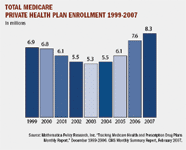Managed Medicare in the Marketplace: Key events have shaped products, payments for managed Medicare plans
Medicare Advantage (MA) plans are increasingly under financial scrutiny. Some fear they might suffer the same fate as Medicare + Choice in the late 1990s when MCOs pulled the plug on plans because of low payments.
Medicare Advantage (MA) plans are increasingly under financial scrutiny. Some fear they might suffer the same fate as Medicare + Choice in the late 1990s when MCOs pulled the plug on plans because of low payments.
Currently, MA plans are facing a determined attack in Congress, with opponents claiming the program is overfunded. Just before the summer recess, the House passed a bill to cut funding levels for Medicare Advantage by $50 billion over five years. The funds would be used instead for the State Children's Health Insurance Plan (SCHIP), and to roll back a scheduled 10% cut in Medicare payments to physicians.
Congressional Budget Office Director Peter Orszag, testifying before the House Ways and Means Committee in March, predicted that if these cuts go through, MA enrollment will fall from approximately 8.3 million today to 6.5 million in 2012. A study by Kenneth E. Thorpe, professor of health policy and management at Emory University, estimates the cuts would mean 11 states losing more than 100,000 MA enrollees each, while an additional 13 states would lose between 50,000 and 100,000.

"The commission believes that greater efficiency is achieved when organizations face financial pressure," MedPAC chairman Glenn M. Hackbarth told the Senate Finance Committee. "The Medicare program needs to exert consistent financial pressure on both the traditional program and the Medicare Advantage program."
SAVINGS THROUGH MANAGED CARE
When Medicare HMOs were first introduced, they were expected to save money as well as improve care management, and the original payment levels were pegged at 95% of traditional Medicare costs.
In the Balanced Budget Act of 1997 (BBA), Congress renamed the program Medicare + Choice (M+C), and authorized new forms of managed Medicare, including preferred provider organizations (PPOs) and private fee-for-service plans. At that time, there were almost no rural Medicare managed care plans in part because payment levels were low and there was a limited number of providers in rural areas.
Legislators from rural states wanted their constituents to have the benefits of managed Medicare, therefore, the BBA established rural floors, with payment rates intentionally set above the Medicare fee-for-service (FFS) level. In 2000, the Benefits Improvement and Protection Act provided for an increase in the BBA floor payment, and introduced a floor payment for metropolitan areas with more than 250,000 residents.
In addition to changes in managed Medicare, the 1997 legislation focused on the federal budget as a whole, and aimed to reduce future deficits by limiting the growth of total Medicare payments. During the late 1990s, M+C followed spending in FFS Medicare, and FFS Medicare grew more slowly than was anticipated.
"In fact, in one year, it actually dropped," says Gail Wilensky, a senior fellow at Project HOPE. "At the same time, prescription drug spending, which was almost always part of Medicare + Choice plans, was growing very rapidly. So you had unusually low premium increases for plans at a time when their costs were growing fast."
As a result, many plans withdrew from the M+C program, or reduced their service areas. From 1999 to 2002, the number of M+C contracts fell from 407 to 240, a 59% decrease. A substantial number of members had to change health plans or switch to traditional Medicare.
Congress was caught by surprise, says Stuart Guterman, senior program director at The Commonwealth Fund.
Extending the Capabilities of the EHR Through Automation
August 2nd 2023Welcome back to another episode of "Tuning In to the C-Suite," where Briana Contreras, an editor of Managed Healthcare Executive, had the pleasure of chatting with Cindy Gaines, chief clinical transformation officer at Lumeon.
Listen
Automate Your Practice's Workflows with These 5 Tools
October 4th 2023To maintain patient satisfaction and regulatory compliance and reduce potential clerical errors while maintaining high productivity, you can ease your staff’s burdens by automating your practice’s workflows and empower your staff to do more in less time.
Read More